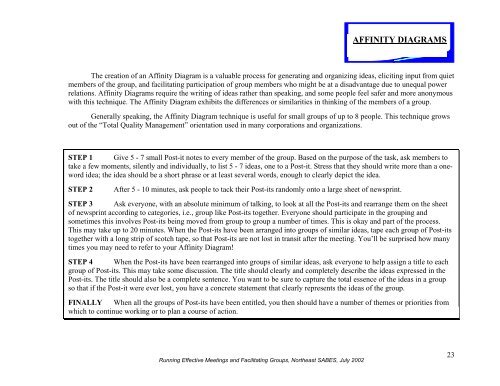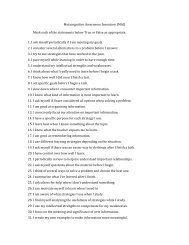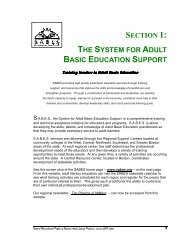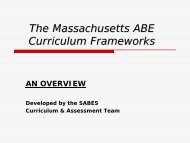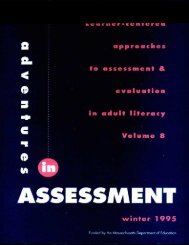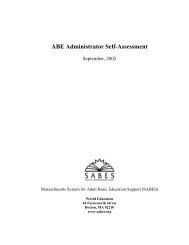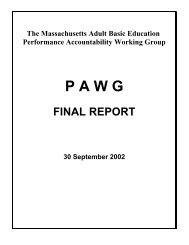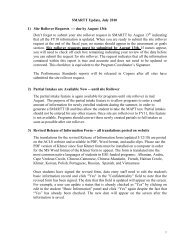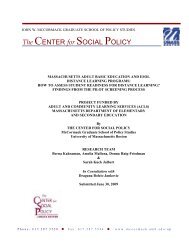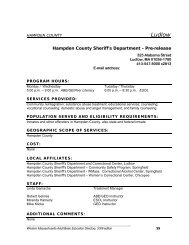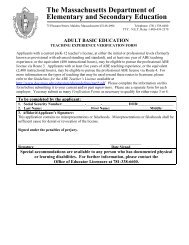Running Effective Meetings and Facilitating Groups - SABES
Running Effective Meetings and Facilitating Groups - SABES
Running Effective Meetings and Facilitating Groups - SABES
Create successful ePaper yourself
Turn your PDF publications into a flip-book with our unique Google optimized e-Paper software.
AFFINITY DIAGRAMS<br />
The creation of an Affinity Diagram is a valuable process for generating <strong>and</strong> organizing ideas, eliciting input from quiet<br />
members of the group, <strong>and</strong> facilitating participation of group members who might be at a disadvantage due to unequal power<br />
relations. Affinity Diagrams require the writing of ideas rather than speaking, <strong>and</strong> some people feel safer <strong>and</strong> more anonymous<br />
with this technique. The Affinity Diagram exhibits the differences or similarities in thinking of the members of a group.<br />
Generally speaking, the Affinity Diagram technique is useful for small groups of up to 8 people. This technique grows<br />
out of the “Total Quality Management” orientation used in many corporations <strong>and</strong> organizations.<br />
STEP 1 Give 5 - 7 small Post-it notes to every member of the group. Based on the purpose of the task, ask members to<br />
take a few moments, silently <strong>and</strong> individually, to list 5 - 7 ideas, one to a Post-it. Stress that they should write more than a oneword<br />
idea; the idea should be a short phrase or at least several words, enough to clearly depict the idea.<br />
STEP 2<br />
After 5 - 10 minutes, ask people to tack their Post-its r<strong>and</strong>omly onto a large sheet of newsprint.<br />
STEP 3 Ask everyone, with an absolute minimum of talking, to look at all the Post-its <strong>and</strong> rearrange them on the sheet<br />
of newsprint according to categories, i.e., group like Post-its together. Everyone should participate in the grouping <strong>and</strong><br />
sometimes this involves Post-its being moved from group to group a number of times. This is okay <strong>and</strong> part of the process.<br />
This may take up to 20 minutes. When the Post-its have been arranged into groups of similar ideas, tape each group of Post-its<br />
together with a long strip of scotch tape, so that Post-its are not lost in transit after the meeting. You’ll be surprised how many<br />
times you may need to refer to your Affinity Diagram!<br />
STEP 4 When the Post-its have been rearranged into groups of similar ideas, ask everyone to help assign a title to each<br />
group of Post-its. This may take some discussion. The title should clearly <strong>and</strong> completely describe the ideas expressed in the<br />
Post-its. The title should also be a complete sentence. You want to be sure to capture the total essence of the ideas in a group<br />
so that if the Post-it were ever lost, you have a concrete statement that clearly represents the ideas of the group.<br />
FINALLY When all the groups of Post-its have been entitled, you then should have a number of themes or priorities from<br />
which to continue working or to plan a course of action.<br />
<strong>Running</strong> <strong>Effective</strong> <strong>Meetings</strong> <strong>and</strong> <strong>Facilitating</strong> <strong>Groups</strong>, Northeast <strong>SABES</strong>, July 2002<br />
23


